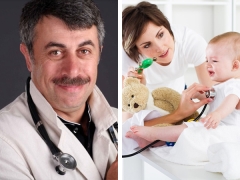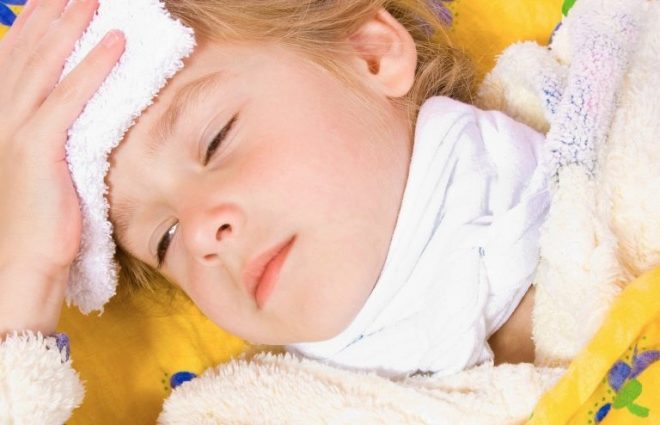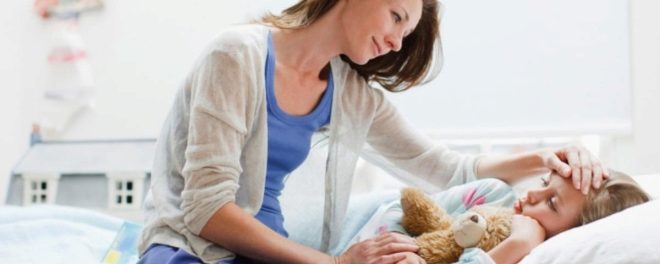Dr. Komarovsky about bronchitis
The child has bronchitis. The situation is not uncommon, because it is this disease of the respiratory system that is considered one of the most common in children. It has many faces - bronchitis has an extensive classification and a lot of different symptoms. The treatment of this disease is also abundant, which is why parents often have questions related to the causes of the disease, the approach to treatment and prevention. The famous children's doctor of the highest category, Yevgeny Komarovsky, answers them often. We tried to collect in one article the maximum of useful information from this specialist.
About the disease
Bronchitis is an inflammatory process in the bronchi, both in the mucous membrane and in the deeper tissues. The disease is more common in children than in adults, with babies from a year to 3 years being most susceptible to ailment. But in older children, this disease is not at all uncommon. Thus, according to a study by the Ministry of Health, during a mass examination of children aged 8-10 years, bronchitis was found in 9% of all young patients. Boys are almost 3 times more likely to get bronchitis than girls.
More than 80% of cases are caused by viral pathogens. Most often it is respiratory viruses, much less - bacteria, also mycoplasma and chlamydia. Often, bronchitis becomes a complication of influenza, parainfluenza, measles and whooping coughas well as the consequence of bacterial lesions staphylococcus, pneumococci and streptococci.
Only 3% of all diseases are associated with exposure to bronchi of inhaled poisons, toxic compounds, vapors of acids and gases. In children, an allergic reaction to an angiogen enters the bronchitis stage in 10% of cases.
Among children from 3 to 12 years old (according to the World Health Organization) 97% at least once suffered from bronchitis, about 60% of children suffered this disease several times, about 20% suffer in chronic form.
Kinds
There are several types of disease, which depend on the origin of the disease:
- Infectious. This type of bronchitis is the most common, it is caused by bacteria and viruses.
- Non-infectious. This disease is caused by allergens, harmful gases, and vapors of toxic chemical compounds.
- Mixed (combined). The doctor will make such a diagnosis if it turns out that the causes of bronchitis are multiple (for example, an allergic reaction to something with the recent flu).
- Abnormal (idiopathic). This is bronchitis, the causes of which cannot be established.
In addition, the disease is different in time of flow, form and manifestations:
- Acute bronchitis. The most common type of disease. Usually caused by viruses or bacteria, proceeds with pronounced symptoms. Often accompanied by bronchospasm.
- Chronical bronchitis. This form of the disease occurs when the acute form of the disease was cured incorrectly or, in general, was not treated. In the chronic course of the disease, the child feels attacks at least once every three months, the peak of manifestations occurs in autumn and spring, as well as during periods of mass incidence of viral infections. Cough in chronic bronchitis is poorly amenable to drug therapy.
- Obstructive. This form of bronchitis is quite well distinguishable. In her case, the child has difficulty breathing, while exhaling and inhaling, a characteristic whistle and wheezing in the bronchi is heard, the baby suffers from severe shortness of breath.This disease may be associated with a genetic predisposition, with a severe viral infection, and severe air pollution.
According to the degree of inflammation, bronchitis can also be different:
- Catarrhal
- Hemorrhagic.
- Combined.
- Purulent.
- Fibrous
Sometimes bronchitis is deployed not only in the bronchi, but also captures the area of the trachea, such an ailment called tracheobronchitis.
According to the severity of the course of the disease is divided into three main forms - mild, moderate and severe.
Forecasts of doctors for bronchitis depend on the type and form of the disease. With timely treatment to the doctor and the right approach to treatment acute bronchitis can be completely cured in 99% of cases. Only 40% of chronic and obstructive cases can be cured. Allergic bronchitis itself is not treated until the cause of the reaction has been eliminated. Usually it passes by itself after the antigen has been identified and eliminated.
Symptoms
If it is possible to establish the exact cause of the disease only with the help of doctors and laboratory techniques, then bronchitis in a child can be suspected quite easily and at home. The symptoms of this disease are quite characteristic. These include a strong cough, in which the child separates a large amount of bronchial secretions (sputum). Less commonly, coughing is unproductive, without sputum. With a debilitating cough, the child will complain of chest pain. Dyspnea is often noticeable even after minor physical actions.
In some cases, the child has blueness of the skin, pallor, small splashes of blood may appear in the sputum. Every second child with bronchitis has a fever, and all, without exception, have headaches of varying intensity and severe general weakness, lethargy, and excessive sweating.
The reasons
Initially, the bronchi perform an important protective function - to block pathogens and viruses. When the immune defense is weakened, and the number of pathogens is large, more mucus is produced in the bronchi, and if its output is difficult, an inflammatory process develops. This is the typical mechanism for the onset of bronchitis.
Among the reasons for the development of such a disease, the most frequent doctors consider infection, concomitant hypothermia (cold). Bronchitis often develops in children who breathe too dry, excessively humid or polluted air. Sometimes the disease is provoked by defects and diseases of the nasopharynx (if the nose “does not breathe”, if the child has recently pharyngitis, sinusitis or tracheitis).
Opinion of Dr. Komarovsky
To blame himself for the child’s illness, as many parents do, Komarovsky does not advise, because very few people manage to raise a child who has never had bronchitis in his life. So, this typical “children's illness”, and moms-dads just need to know more about it.
And now the main issue of Dr. Komarovsky dedicated to children's bronchitis.
Bronchitis, according to a reputable doctor, can have three main manifestations - bronchospasm, bronchial edema, and excessive mucus formation. These processes start some time after the child inhaled allergens or viruses-bacteria with air. The above three manifestations interfere with the normal passage of air through the bronchi.
All these processes cannot be seen, the doctor can hear them, having listened to the child with a phonendoscope, and only if he hears that the passage of air in the bronchi is disturbed, the breathing is “hard,” wheezing, gurgling, then he will have the first good reasons for making the diagnosis .
Yevgeny Olegovich stresses that considering hypothermia as the cause of bronchial inflammation is the main parental mistake, which is caused by insufficient knowledge of moms and dads in the field of children's health.
Acute bronchitis, according to Komarovsky, in 99% of cases is a consequence of an acute respiratory viral infection, of which children are infected by airborne droplets.Influenza A and B viruses most often cause bronchitis, because bronchial cells are the most favorable environment for their existence. Therefore, the doctor does not consider that the child’s immunity, his state of health or something else affects the development of the disease. Whether it will be bronchitis or not depends only on the type of virus that has entered the airways of the baby.
The remaining 1% is bacterial bronchitis. To distinguish it from the usual difficult, but possible. The main thing, says Komarovsky, is to objectively assess the condition of the child. If bronchial inflammation is caused by bacteria, it will feel not just bad, but very bad. He will have the highest fever, vomiting, severe intoxication, in the absence of rhinitis. This condition is not treated at home, in principle, because the child must be called in as soon as possible by an ambulance and taken to hospital.
The most insidious Evgeny Komarovsky considers obstructive bronchitis, it is he who often gives severe complications - pneumonia or, as it is also called, pneumonia and bronchopneumonia. With such diagnoses, he advises to be treated in a hospital.
To know the causes, symptoms and mechanisms of bronchitis, according to Yevgeny Komarovsky, all self-respecting parents should. But not in order to arbitrarily practice in the most different ways of popular and non-traditional treatment, but only in order to be able to consult a pediatrician in a timely manner.
Treatment
It is absolutely impossible to treat bronchitis on its own, without resorting to a specialist, home-made recipes that are abundant in the arsenal of most grandmothers. Yevgeny Komarovsky encourages parents to prudence and with each discussion of this topic reminds that acute bronchitis, which was treated with traditional medicine and respiratory gymnastics, becomes chronic in 99% of cases, which means that it can hardly be cured.
The other extreme is when parents immediately rush to the pharmacy and buy everything they can from coughing. Medicines are not always appropriate, for example, with bronchitis with a dry cough, which was the result of a cold in a child, bronchial mucous membranes just dried out, as the baby breathed through the mouth for several days because of rhinitis. In this situation, simply moisten the air in the house, give the child more drink. And, probably, no other treatment will be needed.
However, the final word in the choice of therapy - for the doctor. If the disease is not complicated, then you can be treated at home, if the baby is too small, and bronchitis is rather severe, accompanied by respiratory and heart failure, then Komarovsky insists on treatment in the hospital. Bronchitis in infants - should always be treated in the hospital, with constant supervision of specialists.
The use of antibiotics for acute bronchitis is often not the best solution, says Yevgeny Komarovsky. Since the overwhelming majority of causes are not in bacteria, but in viral pathogens, and antibiotics are useless against them. And besides harm to the child's body will bring absolutely no benefit.
If the causes of bronchitis are not known, and in the early days of the disease, antibiotics should be avoided. If the virus infection is to blame, the child’s condition will not worsen, there will be no point in antibacterial drugs. If the baby begins to feel worse, Komarovsky strongly advises that he be hospitalized and treated in the hospital.
They will take tests for bacteriological culture and find out if bronchitis is caused by bacteria or fungi. This, though rarely, but possible. Only then it will be possible to discuss the possibility of treatment with antibiotics. In all other cases, antimicrobials for bronchitis only increase the risk of developing pneumonia.
With regard to antiviral drugs, they are also better not to get involved, says Komarovsky.Especially advertised drug "Bronchox", which mothers so love to buy "in case of bronchitis" kiddies. This tool is an immunostimulant and is useful only for children with severe immunodeficiency. Immunity of an ordinary, average child is able to activate independently, Komarovsky emphasizes.
To the logical question of how to treat bronchitis correctly, Komarovsky responded that the scheme should include expectorant drugs, which will allow the sputum to be removed from the bronchi more quickly. There will be no stagnation of the secretory fluid - inflammation will decline. In the acute form of the disease, especially if the child has a fever, the doctor does not advise resorting to massage, inhalation and various compresses. All these methods have their time, usually they are great at later stages, speeding up the child’s recovery.
Allergic bronchitis is treated by analogy with asthma, relying on drugs against allergies (hormonal corticosteroids). Antihistamines in this situation will only worsen the condition of the baby, as they additionally dry the mucous membranes, which is extremely dangerous with bronchitis.
Comment Dr. Komarovsky on allergic bronchitis.
About home ancillary treatment
Massage
In case of bronchitis, Komarovsky advises to use a special type of massage, aimed at improving the drainage functions of the bronchi. For this child lay on his knees face down so that his butt is a level above the head. The hands of the baby should hang down. Adults make tapping movements on the back of the child in the area of the lungs.
After this, the child must be planted abruptly on his knees and asked to cough. Sputum output will occur immediately and more intensely. This method, of course, is not suitable for treatment in infants.
Another massage technique according to Komarovsky's method is to put the child on his knees with his back to himself. Ask him to take a deep breath and cough strongly on the exhale. At that moment, when the child begins to cough, an adult makes light movements, tightening the chest with both hands in the area of the ribs.
But actually the video of Dr. Komarovsky about the correct massage for bronchitis
Inhalation
Komarovsky recommends all moms and dads who like to treat cough in a child with warm steam inhalations to remember what happens to the dry zest when it is treated with steam or boiling water. Yes, it grows in size. The same thing happens with the dried crust of sputum in the bronchi. This is the main danger of inhalation, and you should be aware of it.
A child who is more than 5 years old is able to cough up with an increase in sputum during inhalation. But the baby under five can feel much worse. Therefore, Komarovsky categorically forbids the inhalation of hot steam to children.
And now we will listen to Dr. Komarovsky about whether inlalations help with bronchitis.
If you still really want the child to breathe medicine, you can be very careful inhalation using a special device - a nebulizer. It disperses the drug solution into small particles, which quickly reach their destination by inhalation. Such a method has nothing to do with a hot couple, but it cannot be considered completely safe either.
Komarovsky reminds that the use of antibiotics in the form of solutions for a nebulizer is unacceptable, because a child with bronchitis simply does not need them. It is better if the baby will inhale solutions with essential oils and herbs that facilitate the discharge of sputum (licorice root or anise, for example).
Swimming and walking
Refusing to swim and walking during the treatment of bronchitis is the greatest misconception, according to Yevgeny Komarovsky. Bathing is not prohibited, provided that the child does not have a high temperature. As soon as it has gone down, you can take water procedures, this is useful for improving blood circulation.However, Evgeny Olegovich advises to do this with caution, preferring the soul rather than the hot tubs. And walks with inflammation of the bronchi are necessary, since fresh air to sick bronchi is like a balm for wounds.
Tips
- If your doctor makes a diagnosisbronchitis"And immediately prescribes treatment antibiotics, A “savvy” mother can (and should!) Object. Komarovsky allows you to refer to yourself, they say, the doctor said that bronchitis is a viral infection, and with her antibiotics are inappropriate.
Afraid to cause the displeasure of the attending physician is not necessary, says Komarovsky. Usually, all pediatricians are well aware that bronchitis and antibiotics are completely incompatible concepts, but they prescribe such medications in order to be "safe". After all, if this is not done, pneumonia may be a possible complication, the parents will blame the doctor.
- To rub the chest and back of the child with bronchitis with a high temperature Komarovsky does not recommend. Any rubbing helps to increase body temperature. And if a child is smeared with fat (badger, for example), then such actions of adults reduce sweating in the offspring, and such treatment will not bring benefit.
- For the successful treatment and prevention of bronchitis in the future plays the role of the environment. Evgeny Komarovsky reminds that the mucous membrane of the bronchi will not dry out and become inflamed if the air in the apartment is sufficiently humidified (up to 50-70%). To achieve this, he advises to buy a special device-humidifier. And actively use it. Especially in winter, and especially if the house includes heaters that mercilessly dry the air.
If the financial capabilities of the family do not allow you to purchase such a device (it is not cheap!), Then you can do with improvised means. To humidify the air, you can hang out wet sheets and towels in the apartment, put basins of water in the corners and have an aquarium with fish, often do wet cleaning.
- The air temperature in the apartment, ideally should be no more than 18-20 degrees. If it is customary in the family to tightly close the vents in the winter, to melt and muffle the child, believing that heat and stuffiness will protect him from bronchitis, then the result will be diametrically opposite.
- When treating a child with bronchitis, Komarovsky assigns the importance of abundant warm drink. It helps to prevent the drying of mucous membranes of the nasopharynx, trachea and bronchi. It will be good if mom, after the medical diagnosis has been sounded, will run not to the nearest pharmacy for antibiotics, but to the market for dried fruits. Best of all, according to Komarovsky, to give the child exactly such a compote, tea, broth of hips, berry fruit drinks will also work.
If you change the lifestyle of the family, taking into account all the above points, create a child an optimal environment for healthy and normal growth, bronchitis will no longer be a pressing problem, and even chronic forms of this disease, when the baby coughs for several months a year, gradually recede. Authoritative specialist Evgeny Komarovsky guarantees.













































